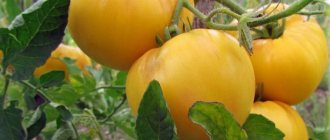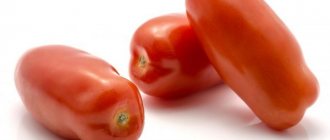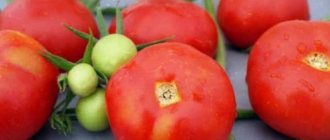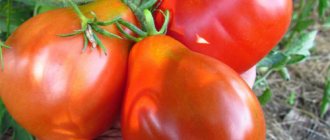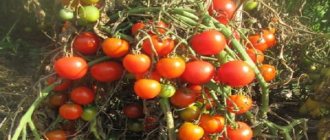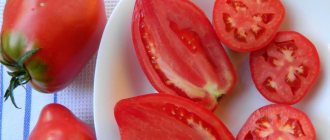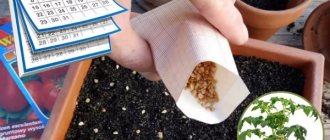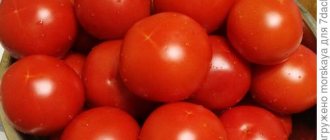Creating a holiday is not at all difficult, especially when you have the Walford Miracle tomato. It will suit everyone who has tall greenhouses and trellises on their site. Belongs to a collection line and was born in the USA.
| Height | Landing location | Ripening time | Fruit color | Fruit size | Origin | Fruit shape |
| Tall | Greenhouse, Open ground | Mid-season | Pink | Large | Variety | Heart-shaped |
Description of Walford Miracle tomatoes
A light-loving plant of indeterminate type rises up to 2 m, and even higher in nutritious soil. The stem is weak for large-fruited tomatoes and requires tying each cluster to the trellis. For greater yield and uniform distribution of ovaries, the Walford Miracle variety is grown in 2 trunks. Tomato leaves are small and not dense. The first flower clusters are formed after 6-7 leaves. 5-14 buds are formed on the inflorescences.
In a greenhouse, the Walford Miracle bush forms up to 8-9 fruit clusters. And in open ground, the variety grows lower, up to 1.6 m, and produces 4-6 complex inflorescences. To ensure large fruits, leave no more than 5 ovaries on one cluster. The fruits ripen 115-118 days after the sprouts appear.
The fruits of the American selection with the promising name Miracle grow quite large, from 6-10 cm in diameter. The tomatoes form a so-called heart shape and are moderately ribbed. There are options: sometimes tomatoes are too elongated, sometimes two fused flowers form a boat silhouette in a longitudinal section. The weight of tomatoes ranges from 170-200 g – the smallest ones, to 600-700 g, which can be obtained with good care. On average, the weight of the fruit of the variety bred by farmer M. Walford is 270-360 g. The color of the dense skin and pulp is pink, turning into intense crimson. The tomatoes are juicy, fleshy, the seed chambers are small and sparse, and there are few seeds.
Attention! With good care, the variety is high-yielding and pleases with large fruits. Tolerant during periods of changes in night and day temperatures.
Delicacy tomato “Sweet Miracle”: description of the variety and secrets of cultivation
Lovers of large tomatoes with a pleasant taste are ready to put up with their moderate yield, difficulties in care and other nuances.
Those who have tried the original fruits of the Sweet Miracle variety at least once will never refuse them.
Tall bushes are planted in greenhouses and greenhouses, and the harvest is harvested in the second half of summer.
- Tomato Sweet Miracle variety description
- Origin and application
- Photo
- Advantages and disadvantages
- Features of cultivation
- Pests and diseases: how to deal with them
- Useful video
Sweet Miracle is a mid-season, high-yielding variety.
The bush is indeterminate, tall, spreading, and requires obligatory pinching.
In a greenhouse, the plant reaches 1.8 m in height. The leaf is dark green, simple. The fruits ripen in small clusters of 3 pieces.
The yield is average; up to 10 very large tomatoes can be harvested from a bush. Ripening is gradual, the last ovaries form at the end of summer.
The fruits are large, weighing from 600 g to 1 kg. The shape is heart-shaped or comb-shaped, elongated. The color of ripe tomatoes is deep red. The pulp is small-seeded, fleshy, juicy.
The taste of tomatoes is delicious, richly sweet, expressive. Subtle pleasant aroma. The high sugar content makes the variety ideal for dietary and baby food.
The Sladkoe Miracle variety was bred by Russian breeders and is intended for closed ground: film greenhouses or greenhouses. In warm climates, planting in open beds is possible.
The fruits are well stored and can be transported. Tomatoes picked green ripen quickly at room temperature.
The fruits are salad fruits, they are very tasty fresh, suitable for making soups, side dishes, snacks, and purees. Ripe tomatoes make wonderful sweet juice.
The photo shows the Sweet Miracle tomato:
Advantages and disadvantages
Among the main advantages of the variety:
- high taste qualities of fruits;
- good preservation of collected tomatoes;
- resistance to major diseases.
Among the disadvantages are:
- the need for formation;
- a tall bush needs strong support;
- The yield is not too high, it depends on the intensity of fertilizing.
Features of cultivation
Seeds are sown for seedlings in late March-early April. Light soil is used from a mixture of garden soil with humus and river sand. You can add a little superphosphate, potash fertilizer or wood ash to the substrate.
Before sowing, the seeds are soaked in a growth stimulator; they can be disinfected in a pink solution of potassium permanganate. Sowing is carried out at a depth of about 2 cm, the plantings are sprayed with warm water and covered with film.
For successful germination, a temperature of 23-25 degrees is needed.
After germination, the containers are moved to bright light and periodically rotated for uniform growth.
When the first pair of true leaves unfold on the seedlings, they are planted in separate pots and fed with liquid complex fertilizer. Stronger sprouts are hardened by taking them out into the open air, first for several hours, and then for the whole day.
Transplantation to a permanent place of residence is carried out when the plants are 60 days old.
The soil is carefully loosened and fertilized with a fresh portion of humus. But 1 sq. m you can place no more than 3 plants; thickening of plantings greatly reduces the yield.
Immediately after planting, tall bushes are attached to stakes or a trellis. As the fruits ripen, heavy branches also need to be tied up.
It is recommended to water the plants as the soil dries out with warm, settled water.
During the season, the bushes need to be fed with complete complex fertilizer at least 3 times. For greater productivity, plants are formed into 2 or 3 stems, removing excess shoots after 4-5 shoots.
Pests and diseases: how to deal with them
The tomato variety Sweet Miracle is not too susceptible to disease. Early ripening protects fruits from late blight; proper watering and timely ventilation help prevent root, apical or gray rot.
Plantings may be threatened by insect pests. At the beginning of summer, plants are attacked by spider mites, which insecticides help get rid of. They spray the plantings 2-3 times with an interval of 3 days. You can get rid of aphids using a warm soapy solution.
Sweet Miracle tomatoes are an interesting variety worthy of a place in the greenhouse. Several bushes will provide the gardener with tasty and healthy fruits; seed material for the next seasons can be collected independently, from ripened tomatoes.
Pros and cons of the Walford Miracle tomato variety
Although growing Walford Miracle tomatoes involves fulfilling mandatory care requirements, the variety is attractive to gardeners for its striking advantages:
- average ripening period - early or mid-August;
- long fruiting, up to frost;
- large fruit;
- high gastronomic assessment;
- stable yield.
The disadvantages of the characteristics of the salad tomato variety include:
- the need to garter the brushes and stems;
- providing plants with a highly nutritious substrate.
General characteristics of the variety
The Walford Miracle tomato variety is an indeterminate tomato. Plants reach 1.7-2 m when grown in a greenhouse. In open ground, tomato growth stops with the onset of cool nights and reaches about 1.5 m.
In terms of ripening period, Walford's Miracle is a mid-season variety. It takes 115-130 days from sowing to harvesting the first tomatoes. In central Russia, ripened fruits can only be obtained in mid-August. Most of the crop will have to be harvested unripe. When cultivated in a greenhouse, the growing season lasts a little longer, and the gardener will be able to get more ripe tomatoes.
Walford's Miracle tomato bushes are distinguished by low foliage of the stem. This eliminates the unnecessary work of removing part of the green mass. Plants need to be pinched, as the bushes branch well. To increase productivity, the bush is formed into 2 stems.
The description of the Walford Miracle tomato notes its main drawback - its thin stem. Because of this, the seedlings look elongated and weak, but when transplanted, they quickly begin to grow and soon form a flower cluster (above 6-8 leaves). To prevent young plants from being broken by the wind in open ground, they need to be tied up immediately after transplanting. Subsequently, a garter is placed under each inflorescence to prevent the stem from breaking off as the fruit grows.
The yield of the variety may vary depending on the location of the site and weather conditions. When planted on fertile soil rich in organic matter in a sunny, dry summer, it is possible to harvest up to 7-8 kg of tomatoes from 1 bush. The same results can be achieved in a greenhouse. But in a damp and cold summer, Walford's Miracle may not live up to the gardener's expectations.
See also
Description of the Tolstoy Monk tomato, growing rules and plant care
Read
Agricultural technology of tomatoes Miracle of Walford
Tall, large-fruited tomatoes with a delicate taste are grown using conventional methods, sowing seeds for seedlings. In the southern regions they are also planted in holes in open soil enriched with fertilizers.
Warning! Seeds of the rare variety Wolford's Wonder (Walford's Wonder) are purchased mainly in online stores.
Growing seedlings
In order to plant the Walford Miracle variety in a greenhouse by the beginning of May, the seeds are sown in the last ten days of February or early March. For planting in open ground, sowing is carried out at the end of March, beginning of April, which depends on the region. Untreated seeds are soaked in potassium permanganate and then treated with a growth stimulator according to the instructions. It is better to plant a rare variety in peat tablets, placing the container in a warm place above 21 °C. Seeds germinate in 6-7 days. Sprouts in heat can quickly stretch and die, so they are provided with bright light, but not high temperature, up to 18-20 °C. After 6-7 days, the tomatoes are provided with comfortable heat at 23-27 °C and light for 14 hours.
At the 3rd week of growth, the tomatoes are transplanted into pots with a nutrient substrate. Seedlings are fed with complex fertilizers for seedlings at the age of 20-25 days. Support is repeated after 2 weeks. Water so that the substrate is slightly moist and does not dry out.
Landing rules
After 45-50 days, the Walford Miracle seedlings develop up to 6-7 leaves and the first inflorescence begins to form. Those tomatoes that will grow in the garden begin to harden by taking them out into the air. With a growth of 30-35 cm, plants pass:
- planting pattern 50x50 cm;
- the holes are watered with 1.7-2.1 liters of water;
- nitrogen fertilizer is added to the wells;
- transfer, keeping the earthen lump intact.
- After planting, the soil is compacted and mulched to retain moisture.
Watering and fertilizing
In a greenhouse, tomatoes are watered every 2-4 days, and in open ground - depending on precipitation, so that the soil is moderately moist, but not constantly wet. Warm water, infused under the sun or in a greenhouse. It is poured near the plant; in wet weather, sprinkling is not carried out. Up to 7 liters of water are spent on an adult bush to moisten all the small roots. After watering, Miracle Walford tomatoes are fed. In the first half of development, organic fertilizers are used - solutions:
- from mullein;
- bird droppings;
- green mass.
Important! During the fruit filling phase, it is better to use balanced complex preparations that contain the potassium and superphosphate necessary for this period.
Pinching and tying
16-18 days after transplantation, regular pinching of Walford's Miracle tomatoes begins: the shoots that form in the leaf axils are broken off. It is recommended to remove stepsons that have grown more than 4-6 cm. At the same time, the bushes are tied to supports or trellises.
Formation
When pinching, all the shoots that are located under the first brush are broken off. Choose a strong stepson to form the second trunk. As the fruits fill, cut off all the lower leaves. The brushes are also formed, leaving 1-4 ovaries if you want to get large fruits. In August, the tops of the trunks are pinched, stopping the growth of the bush. Also, in the second or third ten days of August, the leaves on the Walford Miracle tomato bush are torn off, leaving only the top ones.
Protection from diseases and pests
The Walford Miracle variety is resistant to most fungal diseases, including root rot and powdery mildew. The plant may suffer from late blight, gray rot or viruses that cause infections. If there are signs of viral diseases, the bushes are removed, since the diseases are incurable. Preventively protect against pests:
- Colorado potato beetles are removed from a rare variety by hand;
- the whitefly does not start in the greenhouse if the requirements of agricultural technology are met;
- aphids retreat when sprayed with a soapy solution from a spray bottle.
Features of cultivation, planting and care
We recommend sowing the seeds of this tomato variety for seedlings 60-65 days before the intended planting in the ground. It is better to pick seedlings at the stage of two true leaves. When planting seedlings in a permanent place per 1 sq. Place 3 plants per meter of prepared area; when forming into 1 stem - 4.
Further care of the plantings consists of removing weeds, timely watering, pinching, fertilizing as necessary and preventive measures to protect plants from diseases and pests.
If you have grown Walford Miracle tomatoes, please write how you rate this variety. What was the yield and taste of the fruits like under your climatic conditions? Briefly describe the advantages and disadvantages of this variety in your opinion. If possible, attach a photo of the entire bush or individual fruits you grew to your comment. Thank you!
Your reviews of the Walford Miracle tomato and additions to the description will help many tomato lovers evaluate this variety objectively and decide whether it is worth planting or not.
Advantages and disadvantages of the Big Carol tomato variety
The most important advantage of such tomatoes is their weight and fleshy, juicy pulp. The taste of the litter is excellent, and it is quite resistant to weather conditions.
- large fruits (400-450 grams);
- pleasant sweet taste of tomatoes;
- high commercial properties of fruits;
- disease resistance.
The American tomato is a variety, so you only need to register its seeds from collectors once, and in the future collect seeds from your plantings.
But in order to grow such a tasty and large tomato, you will have to work hard. The variety requires plant formation and obligatory pinching.
The Big Carol tomato has a peculiarity: it is prone to double flowers (fasciation), and this must be taken into account. To obtain large tomatoes, it is recommended to pluck the flowers in a brush, leaving 2-3 pieces. Large tomatoes are usually formed from deformed inflorescences, and their shape may be slightly clumsy. It is up to the gardener to decide whether to remove or leave such inflorescences. It is believed that most often double flowers appear in the first cluster and can inhibit the development of other fruits. Therefore, double flowers can be removed.
Description of the variety
Walford's Miracle is a medium-ripening variety. About 115 days pass from the emergence of seedlings to the collection of the first fruits.
Tomato is indeterminate. The bushes reach a height of 2 m. The stem is thin, the leaves are small. 3-5 fruits are set on a cluster, and under favorable conditions - up to 12.
The fruits are heart-shaped with an elongated tip, large, bright pink. According to the description, the average weight of a tomato is about 300 g, but individual specimens weigh up to 600 g. The skin of the fruit is thin, there are practically no seeds or voids. The pulp is dense and sweet. The fruits are not prone to cracking.
Tomatoes are used mainly for fresh consumption and for making sauces.
